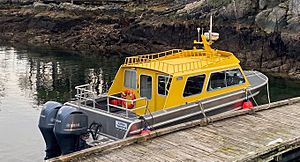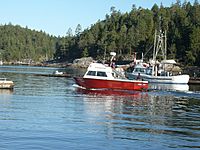Savary Island facts for kids
|
Native name:
Áyhus (Sliammon)
|
|
|---|---|

The south shore of Savary Island
|
|

Location of Savary Island (bottom right)
|
|
| Geography | |
| Location | Salish Sea |
| Coordinates | 49°56′21″N 124°48′48″W / 49.93917°N 124.81333°W |
| Archipelago | Discovery Islands |
| Highest elevation | 68 m (223 ft) |
| Administration | |
| Province | British Columbia |
| Regional district | qathet Regional District |
Savary Island, also known as Áyhus, is a beautiful island in British Columbia, Canada. It's located in the northern part of the Strait of Georgia, about 144 kilometers (90 miles) northwest of Vancouver. The island is about 0.8 to 1.5 kilometers (0.5 to 0.9 miles) wide and 7.5 kilometers (4.7 miles) long.
Around 100 people live on Savary Island all year. In the summer, this number can grow to 2,000 or more as visitors arrive. Savary Island is part of the traditional lands of the Tla'amin Nation.
Contents
Island History: Past to Present
First Peoples on Savary Island
After the glaciers melted, First Nations people came to this area. Evidence from archaeology shows that Coast Salish peoples have lived in the Strait of Georgia region for over 4,000 years. Savary Island is within the traditional territory of the Tla'amin (Sliammon) First Nation.
In the Ayajuthem language, spoken by the Tla'amin people, the island has two names:
- Ihohs (or Áyhus), which means 'double-headed serpent'.
- Kayaykwon, which refers to the three main water sources on the island.
The western tip of the island, called Indian Point by settlers, is known as Thetik or Thah teq in Ayajuthem, meaning 'broken off'. The area known as The Meadow is called T’it’may, meaning 'wild cherry trees'. The spring at Beacon Point is called Xixajayis.
More than 13 archaeological sites have been found on the island. These sites are protected by the BC Heritage Conservation Act. They include a large living area on the eastern side and a signal site on a high point. These sites show what life was like before Europeans arrived.
European Exploration in the 1700s
European ships might have been near the island in the mid-1700s. The Tla'amin (Sliammon) First Nation has stories about a "trading" ship, known for piracy, that sank in their territory around that time.
In 1791, José María Narváez explored the Strait of Juan de Fuca and Strait of Georgia. He saw some higher land in the distance, which might have included parts of Savary Island. In June 1792, ships led by Galiano (Spanish) and Vancouver (British) sailed past the island. Vancouver named it "Savary's Island" around June 25, 1792.
Later, a survey team led by Peter Puget and Joseph Whidbey mapped Savary Island. They spent a night on shore and met some Indigenous people on the island's eastern end. Puget called it "Indian Island" instead of Savary.
European Settlement in the 1800s
Europeans did not start living permanently on the island until later in the 1800s. In the 1870s, the government divided the island into lots for homesteading, even though Indigenous people already lived there.
Jack Green was one of the first non-Indigenous people to live on the island year-round. He built a cabin and a store around 1886. Green Point, now called Mace Point, was named after him. Around 1893, Green and his business partner, Taylor, were killed during a store robbery on Savary. The person responsible was eventually caught after a long chase and faced justice.
Island Development in the Early 1900s
The first hotel, "The Savary," was built in 1914 near the Government Wharf. It operated until 1932, when it was destroyed by fire. Another hotel, the Royal Savary Hotel, was built by the Ashworth family at Indian Point.
Over time, private boats and water taxis from Lund became the main way to reach the island. Steamship services stopped in the 1940s and 1950s.
For a short time, there was an airstrip on the island. However, it was closed due to safety concerns. Today, most people travel to Savary by seaplane or by boat from Lund. Many people who visit for the summer use seaplanes, especially on Friday and Sunday evenings.
Important Events and Changes
Over the years, there have been some shipwrecks and aircraft crashes near Savary Island. For example, the Union Steamship Steamer Capilano sank in 1915. In the 1950s, a 12-year-old boy named Fred Ilott was the only survivor of a tugboat sinking and washed up on Savary.
In the 1960s, ancient human remains were found on Savary. These remains were later returned to the Tla'amin (Sliammon) First Nation in 2006 for proper burial.
The Royal Savary Hotel was taken down in 1982. Since then, several bed and breakfasts (B&Bs) have opened on the island for visitors.
Island Geology and Soils
Savary Island is mostly made of loose materials like glacial till (rock and dirt left by glaciers), marine clay, and sand. These materials were deposited by meltwater streams from glaciers over 20,000 years ago during the Ice Age. Newer deposits from the last 10,000 years, including sand dunes, cover these older materials.
Solid rock can only be seen at the eastern end of the island around Mace Point. Most of Savary's soils are sandy. Since the glaciers melted, about 10,000 years ago, the island has been changing. Strong waves, especially from the southeast, cause erosion and move sand around. This means the island's shape and boundaries are always shifting. One study said that because the island doesn't get new sediment from outside sources, it will continue to "eat away" at its own south coast.
Island Climate
Savary Island is in the "rain-shadow" of Vancouver Island. This means it gets less rain, between 950 and 1,300 millimeters (37 to 51 inches) each year. Most of the rain falls from late fall to mid-winter.
There are no permanent streams on the island, but there is at least one spring called Indian Springs in the middle of the island. The island has dry, warm summers and sandy soils that are easily eroded by wind and water. Storm waves from the southeast also cause important erosion and move sediment along the south shore of Savary.
Island Ecology: Plants and Animals
Flora: Plants of Savary Island
Common trees on Savary Island include Douglas-fir, western hemlock, western red cedar, lodgepole pine, grand fir, red alder, bigleaf maple, and arbutus. It is believed that one of the largest arbutus trees in the world is on the island. A few western white pine trees are also present.
A small group of Garry oak trees grows at the eastern end of the island. This is the most northern natural place where this type of oak tree grows along the coast. Savary Island has beautiful beaches, arbutus groves, meadows, and sand cliffs.
Salal is the most common shrub found under the trees. Other shrubs include Red huckleberry, evergreen huckleberry, and red flowering currant. Some open areas have been taken over by non-native plants like Scotch broom, gorse, and Himalayan blackberry.
Fauna: Animals of Savary Island
The animal life on Savary Island includes many birds, such as:
- Bald eagles
- Barred owls
- Kingfishers
- Cliff and northern rough-winged swallows
- Seagulls
- Sandpipers
- Oyster catchers
- Herons
Mammals found here are:
- Black-tailed deer
- Mink
- Harbour seals
- Sea lions
- Otters
- Bats
- Mice
Reptiles include:
- Garter snakes
- Northern alligator lizard
There are also many small invertebrates (animals without backbones). Interestingly, raccoons are not found on the island. Because raccoons are absent, ground-nesting birds have been able to keep their populations strong. The mink is the only native predatory mammal on land, and it has many mice to hunt.
Island Governance
Before colonization, the Tla'amin Nation governed Savary Island according to their own laws. For many years after colonization, there was no formal government on Savary. Eventually, Savary Island became part of the Powell River Regional District, which is now called the qathet Regional District. In the late 1990s, the Regional District started to create an official community plan for the island.
Draft plans were made in 2001, 2002, and 2006. On February 22, 2007, the Savary Island Official Community Plan, Bylaw No. 403, 2006, was officially adopted. The main goal of this plan is to keep Savary Island's special character and relaxed island lifestyle. It also aims to protect the island's groundwater, sensitive ecosystems, and unique natural features.
Island Culture and Art
Savary Island has been a source of inspiration for many artists. Artists whose work features Savary include Stephanie Aitken, Helen Griffin, Charles Hepburn Scott, Anne-Marie Harvey, David Burns, Sheldon Heppner, Toni Onley, E. J. Hughes, Keith Pepper, and Michael Kluckner.
Since the early 1900s, visual artists have regularly visited Savary Island. In the 1930s, it became a place for summer sketch camps held by the Vancouver School of Art. These camps were often based at the Royal Savary Hotel. Students from these camps even created a newsletter called The Savary Pudding.
The beautiful natural surroundings of Savary also inspired poet Alice Brewer. Her 1926 book of poems, Spring in Savary, features verses about the island.




